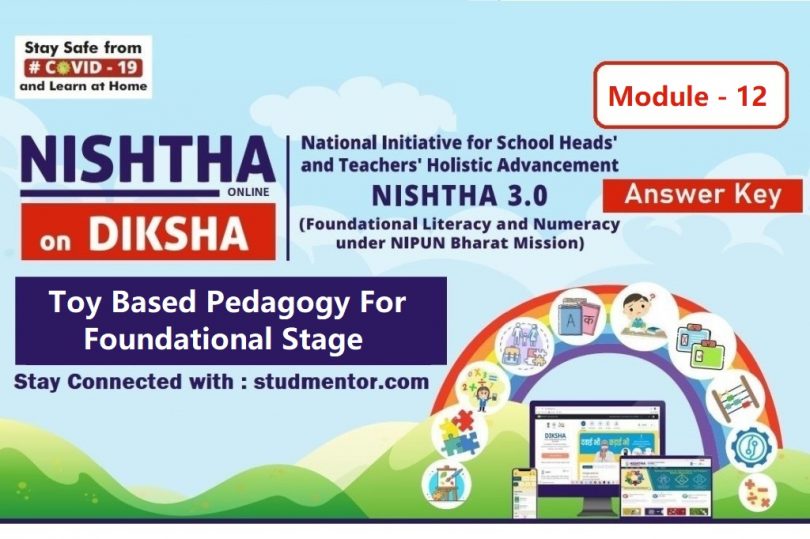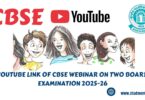FLN_12 Toy Based Pedagogy For Foundational Stage | Nishtha 3.0 Diksha Portal Module 12 Quiz 2022 Answer Key
Nishtha 3.0 Diksha Portal Module 12 Quiz 2022 Answer Key
1. At which stage, learning through toys is most required?
Answer – Foundational and preparatory stage
2. Which among the following is not a D-I-Y idea?
Answer – Buying toy airplane from market and playing with
3. Tech-aided toys helps in?
Answer – Make learning joyful.
4. Which of the following statements is true in the context of toys as educational aid?
Answer – Playing with toys helps in developing important
5. Which is true amongst the following?
Answer – Toys help children to learn about themselves and
6. Which of the following is not an active physical play?
Answer – Computer Game
7. Identify from the following which is a traditional building toy?
Answer – Jigsaw Puzzles
8. Children in the classroom should be permitted to bring their:
Answer – Toys and Games
9. Children love to __________ objects because they are curious and eager to learn by nature.
Answer – Manipulate
10. The Objective of introducing toys across the foundational stages is :
Answer – to promote experiential learning from an early age
11. In which activity area, the kitchen set should be placed ?
Answer – Dramatic Play area
12. Which among the following is a technology-based game?
Answer – Video Game
13. Toy telephones and talking books are some examples of _____ to boost language and communication skills of young children.
Answer– Tech Aided Toys
14. Which of the following is incorrect in relation to ring set puzzles? Ring set puzzle:
Answer – Is made up of glass
15. What is the essential component in implementing a play way, activity-based approach across the foundational stage?
Answer – Child-friendly Environment
16. Ring Set Puzzles help in learning the concept of:
Answer– Seriation
17. Which of the following statements is not correct in the context of indigenous toys?
Answer – Indigenous toys are not easily available.
18. Which of the following is the famous indigenous toy of Gujarat?
Answer – Dhingli Dolls
19. The full form of D-I-Y is:
Answer – Do-It-Yourself
20. At what age, children start demonstrating their willingness to play with others in a structured manner?
Answer– 6-8 years
Example 2
1. The history of toys are traced back to?
Answer – Indus Valley Period
2. Toy center created for young children should have:
Answer – Toys and age appropriate manipulatives and
3. “Play is helpful in the development of language and thought.” Who said this?
Answer – Lev Vygotsky
4. Kaleidoscope is very useful in developing understanding of the?
Answer– Science concepts of reflection and refraction.
5. Indigenous toys are made up of?
Answer – local low cost material
6. Which of the following should not be a consideration while choosing play materials/toys for children?
Answer – Children’s economic status
7. Dhingli toys are also known as:
Answer – Cotton Dolls
8. What is considered a good idea in order to ensure quiet play in small groups amongst children?
Answer– Creating a toy area
9. At which age group Toy Based Pedagogy should be initiated?
Answer – 2-3 years
10. The D-I-Y are should be?
Answer – Well-stocked with materials, neat and organized
11. Toys and educational play materials must not be?
Answer– Culturally irrelevant
12. Kaleidoscope is made up of?
Answer – Cardboard, glass piece and some random pictures.
13. D-I-Y Toys does not challenge children in?
Answer– Spiritual skills
14. Indigenous toys connect children with?
Answer – Culture
15. Which of the following games is not a popular traditional Indian game?
Answer – Cricket
16. Which of the following is not correct in relation to kitchen toys?
Answer – Kitchen toys help in introspecting self.
17. What approach should be practiced in a child friendly classroom across the foundational stage?
Answer – Play-way, toy based, child centered approach
18. Toys aid the young children in ?
Answer – Cognitive development
19. Which of the following is the popular name for the toy ‘Set of Kitchen utensils’ in Gujarat?
Answer – Rasoi
20. Which of the following should be a guiding criteria for selecting the toy for children?
Answer – Toy is appropriate for child’s age
Read Also Previous Nishtha 3.0 Modules
- Nishtha 3.0 FLN Diksha Portal Module 1 Introduction to FLN Mission Quiz Answer Key
- Nishtha 3.0 FLN Diksha Portal Module 2 Shifting towards Competency Based Education Quiz Answer Key
- Nishtha 3.0 FLN Diksha Portal Module 3 Understanding Learners: How children learn? Quiz Answer Key
- Nishtha 3.0 FLN Diksha Portal Module 4 Involvement of parents and communities for FLN Quiz Answer Key
- Nishtha 3.0 FLN Diksha Portal Module 5 Understanding Vidya Pravesh and Balvatika Quiz Answer Key
- Nishtha 3.0 FLN Diksha Portal Module 6 Foundation Language and Literacy Answer Key
- Nishtha 3.0 FLN Diksha Portal Module 7 Multilingual Education In Primary Grades Answer Key
- Learning Assessment Quiz | Nistha 3.0 Module 8 Quiz Answer Key In English
- Nishtha 3.0 Diksha Portal Module 9 Quiz 2022 Answer Key
- Nishtha 3.0 Diksha Portal Module 10 Quiz 2022 Answer Key
- Nishtha 3.0 Diksha Portal Module FLN_11 Quiz 2022 Answer Key
- Nishtha 3.0 Diksha Portal Module FLN_12 Quiz 2022 Answer Key
I Hope you like the Article of the Nishtha 3.0 Diksha Portal Module FLN_12 Quiz 2022 Answer Key. If you like then share to others.
Happy Reading. Stay Connected


